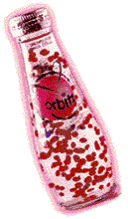Week 1 - Fluids in Technological Devices
Week 1 - Fluids in Technological Devices
1. Unit Introduction and Particle Theory of Matter
Unit Introduction and Particle Theory of Matter
|
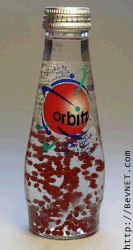
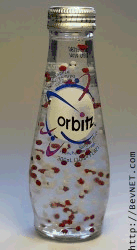
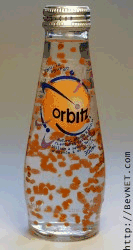
Orbitz is a soft drink that was made by Clearly Canadian in which gel like beads seem to be suspended in the drink. When the bottle is opened the beads seem to be made of water and the whole drink simply pours like water.
Why do the beads float in the fluid and not sink? If the beads pour like water when opened, then why do they not mix with the fluid when they are bumped or moved?
Clearly we need to learn more about the nature of fluids!
| An Orbitz Investigation:
The Net Result By Tim Graham
The beverage industry says that the average American drinks one gallon (3.8 L) of soft drinks each week. Considering that a 1995 census estimated the U.S. population to be 263,874,000 people, that translates into about one billion liters a week! This huge volume means a potentially large profit for soft drink manufacturers, who constantly try to entice you to change brands. One such manufacturer is Clearly Canadian Beverage Corporation, headquartered in Vancouver, British Columbia. Clearly Canadian recently released a unique product they hope will gain a portion of the U.S. marketplace. Sold under the product name Orbitz, this "out-of-this- world" noncarbonated fruit-flavored soft drink is sure to get your attention. Floating in the clear liquid are colorful "orbs," gelatin-like spheres containing complementary flavors that float about in the beverage, seeming to defy gravity. It is this unique property that the manufacturer is counting on to grab the consumers' attention. Half the fun of Orbitz is playing with it before you drink it. No amount of twisting, turning, shaking, heating, cooling, etc., seems to affect its "gravity-defying" properties. But what keeps these flavor spheres suspended? There must be more to Orbitz than meets the eye. Defying GravityOn the basis of a first observation, it would seem that the phenomenon of the floating orbs is density related. If the colored spheres were to remain suspended in the beverage medium, then the spheres and the beverage should have nearly identical densities. Experimentation showed that the density of the orbs and the surrounding liquid are indeed nearly identical. Both have a density between 1.030 and 1.035 g/mL. But one would expect that a two-component system, even of almost identical densities, would separate during the days when the product was being transported from the manufacturing facility to the store shelf. Eventually, all the orbs should sink to the bottom or float to the top, but this never happens to Orbitz. The colored spheres seem to flaunt the law of gravity! Are the flavored spheres held back by something we can't see? The search for an answer was on. Our investigation continued with a simple check of the ingredients listed on the back of the Orbitz bottle. Most are common ingredients found in many brands of soft drinks: water, high-fructose corn syrup, sugar, natural flavors, citric acid, sodium citrate, colors. But a couple are unusual. What are "xanthan and gellan gums"? Could these hold the answer to Orbitz's gravity-defying property? Xanthan gum is a polysaccharide (many-sugar) gum produced by the bacterium Xanthomonas campestris. The primary chemical structure of this gum consists of a cellulose backbone with trisaccharide (three-sugar) side chains and repeating pentasaccharide (five-sugar) units. This giant polymer (its molecular weight exceeds 106 amu [atomic mass units]) has been used in processed foods for years as a stabilizer and an emulsifying agent. (An emulsifying agent is a chemical agent that helps keep one substance evenly dispersed in another. In mayonnaise, egg yolk is the emulsifying agent that keeps the oil droplets dispersed in water. Otherwise, these two "unlike" chemicals would not mix.) Although xanthan gum is a free-flowing powder that dissolves readily in water, just a small amount will make the solution highly viscous. Orbitz is certainly not a highly viscous (viscosity is defined as "resistance to flow") solution, therefore it seemed unlikely that xanthan gum held the answers to our questions. If there were to be a "chemical" answer to the question of how the colored gel spheres were suspended in the Orbitz beverage, it seemed as though gellan gum was the last hope. Gellan gum is a recent addition to the ingredients lists of many processed foods. This polysaccharide is made by Pseudomonas elodea, a bacterium common to the lily pond. According to food-processing experts, gellan gum provides many advantages over more traditional food additives. A gellan gum solution acts like a "gel" that holds particles in suspension but, unlike other gelling agents, it does not significantly increase the solution's viscosity. Chemical engineers incorporated this "Fluid-Gel" technology into the manufacturing of Orbitz. The gellan gum provides a support matrix, something like a microscopic spider web, that holds the flavored spheres in position. An additional benefit of using gellan gum is that it has a visual clarity approaching that of water, and adding sugar promotes this clarity even more. It would seem that Orbitz and gellan gum are a match made in soft-drink heaven! So the answer is finally in hand. The colorful gel-like spheres that first catch our attention do not really defy gravity but are being held in place by a spider web-like support system that is invisible under normal viewing conditions. While the manufacturer claims the unique beverage is "out-of- this-world," we might better regard it as a phenomenon of misplaced worlds. The world of consumer marketing has just been invaded by Pseudomonas elodea,a chemically savvy bacterium from the lily pond!
References "From lily pond to the table." Food Processing, March 1995, p 97. |
Lesson 1
Textbook Readings
ScienceFocus 8
Pages 4-12
or
Science in Action 8
Page 33
Before starting this lesson, take a few minutes and list all of things you already know about solids, liquids, and gases. How are they similar? How are they different? In this lesson, you will be introduced to the particle theory of matter and how it is used to explain the properties of fluids.
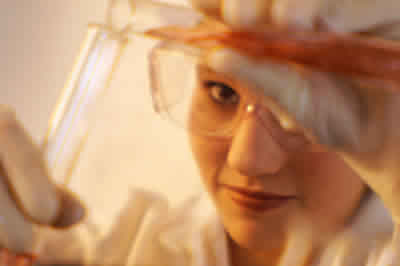
The particle theory of matter is one example of a scientific model . Scientific models help scientists to picture, in an imaginative way, processes in nature that cannot simply or directly be seen. For example, in the particle theory of matter, the individual particles would be far too small and fast-moving to be observed directly. The molecules in the diagram below represent water molecules and how they behave when heated.

|
Particle Theory of Matter
· all matter is composed of tiny particles |
The word fluid comes from the Latin word meaning "to flow." The two most common fluids are liquids and gases. Gases and liquids are fluids because they have no fixed shape and they can flow. The following chart compares liquids and gases and describes why they are considered to be fluids
 |
 |
|
Liquid
|
Gas
|
| have a definite volume | do not have a definite volume |
| when gravity is present, a liquid takes the shape of its container | evenly distributed throughout the surface of any object that they rest upon |
| particles in a liquid state are much further apart than those in a solid | particles in a gaseous state are much farther apart from neighboring particles compared to the particles in a liquid |
| molecules in a liquid state are free to move around within the liquid | gaseous particles move about freely and completely fill their container |
| the particles are closer together than those in a gas | the particles are further apart than those in a liquid |
|
Experiment Time: Investigating Particles
 Scientists use the particle theory of matter to explain the properties of solids, liquids, and gases. Problem: What are the properties of solids, liquids, and gases? Materials: - small block of wood - 2 litre plastic pop bottle - 2 litre measuring bowl (cup) - water - 2 balloons - small pieces of paper Procedure: 1. Prepare a chart similar to the one shown below.
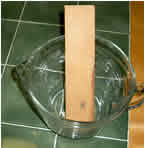 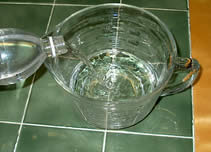 6. Pour the water from the pop bottle into the measuring bowl. Does the water retain the shape of the pop bottle or does it assume the shape of the measuring bowl? Record your observations in the Properties column of your chart. 7. When you poured the water from one container to another, did the appearance or the amount of water change? Record your observations in the Properties column of your chart.  9. Change the shape of the balloon by squeezing and twisting the balloon. What happens to the air inside the balloon? Record your observations in the Properties column of your chart. 10. Inflate the second balloon but do not tie it. Place the end of the balloon near the tiny pieces of paper and release the balloon. Describe what happens to the small pieces of paper when the balloon is released. Record your observations in the Properties column of your chart. |
